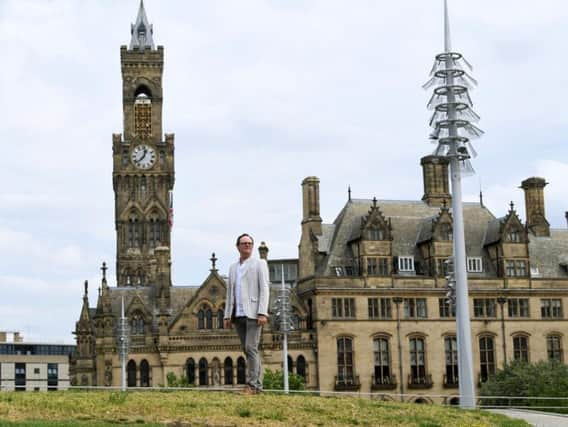How Victorian Bradford made its mark on the history of cinema


It is one of 13 Unesco Cities of Film - and is this year celebrating its 10th anniversary of the title.But before the Victorian era was out, a small group of Bradfordian enthusiasts played their part in the exciting evolution of cinema.
David Wilson, director of Bradford Unesco City of Film, said: "It goes back to our forefathers, when they dabbled in film technology at the turn of the last century because they were passionate about new technology, about storytelling and Bradford's place in the world is so significant."
Advertisement
Hide AdAdvertisement
Hide AdIn 1883, Bradford businessman Joseph Riley bought a magic lantern for his two eldest sons, Herbert and William.
Originally developed in the 16th century, the device projected images from painted or photographed slides, often used for both educational and entertainment purposes.
It led Mr Riley to set up a lantern slide business as part of his existing company, Riley Brothers, run with his brother Sam.
Herbert and William ran the business, where they sold and rented out magic lantern slides and equipment out of their base at 55 and 57 Godwin Street.
Advertisement
Hide AdAdvertisement
Hide Ad-> The double life of Bradford City Hall - used to film the House of Commons, the Old Bailey and Poirot police scenesThe Rileys’ interest in the magic lantern, an early precursor to moving picture presentation, foretold their later involvement in the emerging art of cinematography.
After William attended a demonstration of the Lumière brothers’ Cinématographe in Paris, the Riley brothers became enthused by the idea of moving pictures.
In 1896, the brothers introduced the Kineoptoscope projector, based on the designs of local electrical engineer Cecil Wray.
Wray, a Bradford-based electrical engineer, designed the device to project Kinetoscope images on to a screen.
Advertisement
Hide AdAdvertisement
Hide AdThe Kinetoscope, first produced by Thomas Edison and William Kennedy Dickinson, could only be used by one person at a time, viewing the film through a hole at the top of the device.
Also in 1896, after setting up a business together at Borough Mills, Manchester Road, Mr Wray and Cecil William Baxter designed and manufactured a camera/projector device called the B & W Cinematograph’, and claimed it to be the first such device used in Japan.
-> The Bill Nighy and Annette Bening film shot in Leeds and Doncaster
On Easter Monday 1896, People’s Palace hosted one of the first demonstrations of moving image photography when short films captured on the Lumière’s Cinématographe were projected for the public.
Advertisement
Hide AdAdvertisement
Hide AdThe pictures shown included Barber’s Shop, A Dentist’s Operating Room, Blacksmith’s Forge and A Regimental Band in Evolutions.
Richard James Appleton - the son of Bradford photographer Thomas Appleton - took over his father’s business in the 1890s, and soon became interested in cinematography.
In 1896 he created the Cieroscope, a device which combined the three functions of camera, printer, and projector.
A year later he set himself a challenge: to film Queen Victoria's Diamond Jubilee procession in London and screen it for an audience in Bradford the same day.
Advertisement
Hide AdAdvertisement
Hide AdThe stunt was a success, and an estimated 250,000 spectators are reported to have seen the films projected outside the Bradford Argus building throughout the week.
Mr Wilson said: "They put a dark room in the train carriage. He developed the film on the way back from London that day and showed the film then to thousands of Bradfordians that night on a giant sheet outside a building. It's those kind of inspirational individuals that make those stories just so fantastic."
Unfortunately, the film was lost.
That same year, shortly after the release of their Kineoptoscope projector, the Riley Brothers introduced the Kineoptoscope camera, again based on the designs of their fellow Bradfordian Cecil Wray.
They also started to produce their own films, with titles such as The Three Macs and The Nursemaid’s Surprise.
Advertisement
Hide AdAdvertisement
Hide AdMeanwhile Baxter and Wray patented a new device, the ‘Perfection’ cinematograph, in association with Bradford clockmaker Joseph Oulton. Similar in design to the Riley Kineoptoscope, also designed by Wray, the Perfection Cinematograph could both photograph and project film.
As well as producing filming and projection equipment, the business partners also offered films for sale, including those of early French filmmaker George Méliès.
In 1898, the Riley brothers began to sell and rent out their films to people who bought their projectors in an early example of commercial film sales.
In the same year, St George’s Hall screened a film for the first time in.
Advertisement
Hide AdAdvertisement
Hide AdFilms were shown in colour by 1905 and ‘talkies’ were screened the next year.
By then it had become a major venue for touring films, showing Charlie Chaplin’s The Idle Class among others.
The last film screened at the venue was Pin Up Girl, starring Betty Grable.